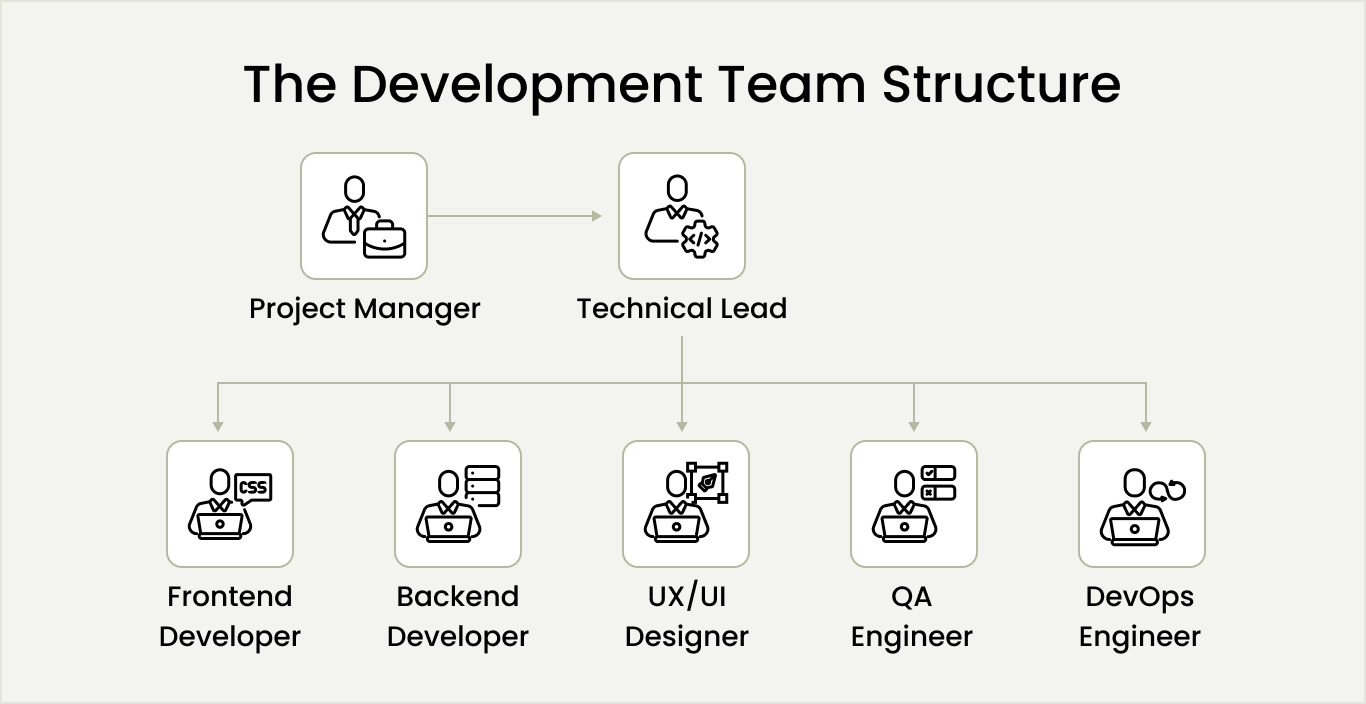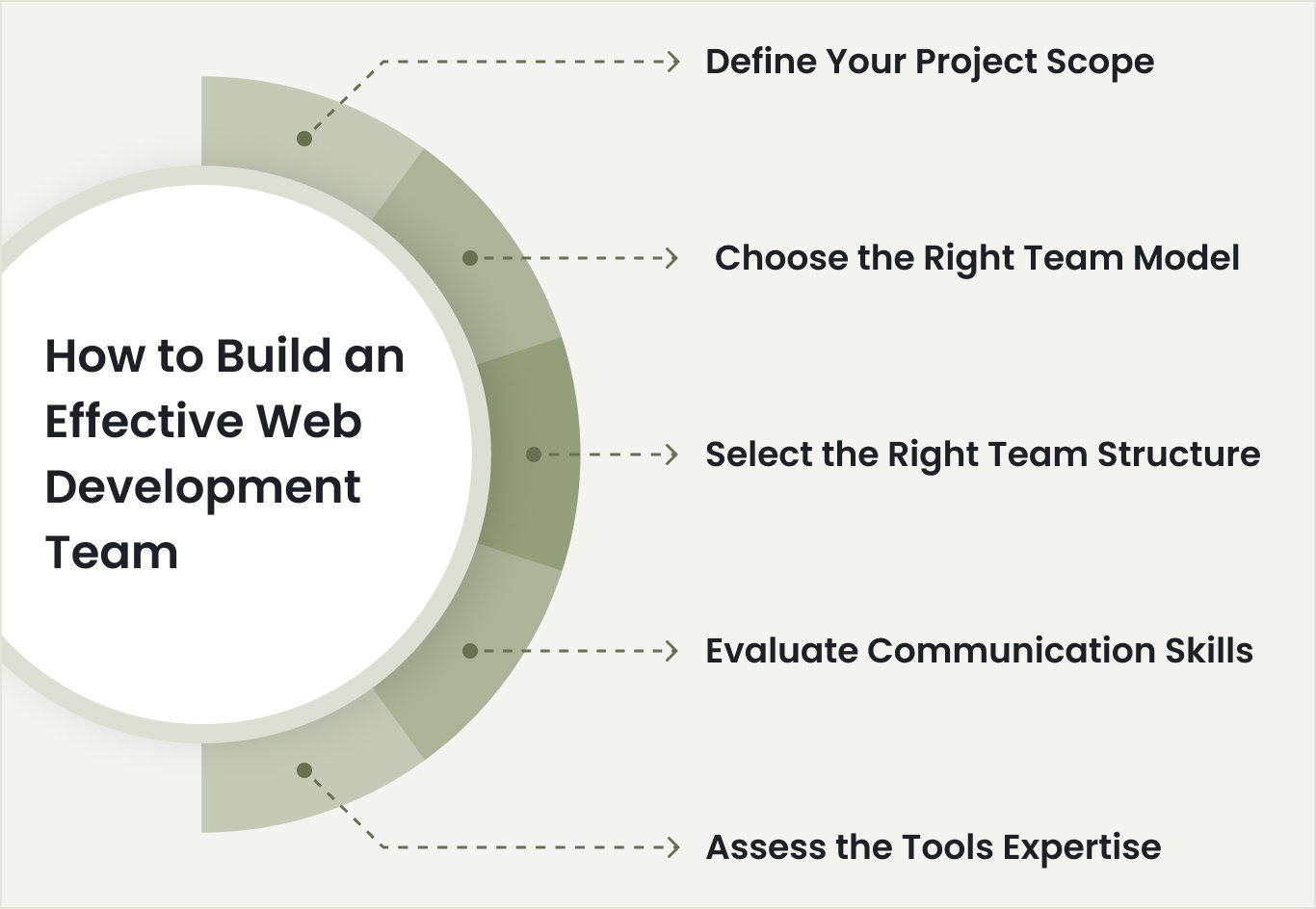Table of Contents
Building a successful digital product isn’t just about writing code. It’s about having the right web development team that can keep up with fast-changing technology, adapt to shifting business goals, and meet rising customer expectations.
That’s where Space-O Technologies comes in. With 15+ years of experience, 300+ successful projects, and 1,200+ satisfied clients worldwide, we know how to assemble and manage high-performing development teams.
In this guide, we will provide quick benefits to hiring a development team, steps to build one for your project, and common mistakes to avoid when building a team. Each section helps you reach your end goal: building a successful development team or finding the right web development company to partner with.
What is a Web Development Team?
A web development team is a cross-functional group of specialized professionals who collaborate to transform your web app ideas into scalable, high-performing applications. Unlike individual freelancers, these development teams combine diverse expertise to handle complex projects from conception to deployment.
Key Benefits of Outsourcing a Web Development Team?
You might be thinking, Why not just hire a solo ‘full-stack’ developer or freelancer? Here’s why strong web development teams consistently outperform individuals, especially as project complexity grows.
Gain access to expertise and diverse skills
The website development teams offer diverse skills (frontend, backend, UI/UX, DevOps, QA, and more). Each web specialist is skilled and experienced in using their expertise to solve complex, cross-domain problems more efficiently.
For example, Space-O Technologies has delivered real-time shipment tracking apps with API integration and an enterprise-grade analytics dashboard. The developers, designers, and QA who worked on this project delivered dedicated expertise in each area and developed the product for the client that drove better results.
Greater reliability and less risk
Hiring a web development team reduces the risk of failure. If a developer is unavailable, the website development continues. It will give you access to a documented codebase that minimizes the project disruptions and accelerates the development and launch of the web application to the market.
Higher code quality
Mandatory peer reviews of fixing bugs over 90% of coding issues that a single developer might miss. Poor code quality not only delays the product launch but also increases development costs due to the increased number of iteration cycles.
When you hire a group of professionals that includes dedicated Quality Analysts (QA), it reduces the delays as they test the code quality and performance at every stage.
Faster delivery and flexibility
Parallel tasking allows UI, backend, and testing to happen at the same time. If you want to launch the product faster, scaling teams up based on project requirements offers you flexibility. But if you want to scale the team down based on changing requirements, you can do that too.
Best-in-class communication
Structured meetings (stand ups, sprint reviews) keep everyone in the loop. The web development teams are well versed in how to communicate smoothly and efficiently throughout the development lifecycle. Using team communication channels(Slack, ClickUp, Jira, Notion), they prevent bottlenecks and silos.
In short, a web development team provides resilience, continuous value delivery, and proven pathways for scaling your digital business.
Now you get the overview of why hiring a team for your web development project is a good move. In the next section, let’s learn about the standard structure and development team roles and responsibilities.
Get the Right Talent for Every Role
From project managers to DevOps engineers, hire a complete web development team tailored to your project’s needs, without the hiring delays.

Understanding the Web Development Team Structure And their Roles and Responsibilities

Learning web development team roles and responsibilities is key to building an effective web team structure. Each role contributes uniquely to turning your vision into a fully functional, user-friendly web solution.
Project manager
A project manager’s role is like an orchestrator who keeps monitoring and ensuring that everything runs smoothly and on time. They possess skills such as specialization in Agile/Scrum methodology, strong communication, and experience in leading product development teams that align with business goals.
Core responsibilities of a project manager:
- Sprint planning and timeline management
- Stakeholder communication and reporting
- Risk assessment and mitigation
- Budget allocation and monitoring
- Quality assurance oversight
Average salary: $121,000 (US)
Technical Lead
This web development role bridges business requirements with technical implementation, making critical decisions about your project’s architecture and technology stack. They define the role of a back-end developer and outline how frontend developers should implement features.
Core responsibilities of a technical lead:
- System architecture design
- Technology stack selection
- Code review and standards enforcement
- Technical guidance for developers
- Integration strategy development
Average salary: $127,330 (US)
Frontend developers
The frontend web developer’s role involves transforming UX/UI designs into interactive experiences. These specialists handle web design tasks that determine user engagement and ensure your application works flawlessly across all devices and browsers.
Core responsibilities of frontend web developers:
- Create SEO-optimize and mobile-friendly frontend using app development languages (HTML5, CSS3, JavaScript (ES6+) and frameworks (React, Angular, Vue.js)
- Animate components (carousels, modals)
- Collaborate closely with designers to deploy frontends with a better user experience.
Average salary: $118,000 (US)
Backend developers
The role of a backend web developer is to architect server side logic and data management. They are skilled in using programming languages like Node.js, Python, and PHP and building databases with MySQL, PostgreSQL, and MongoDB to maintain performance, scalability, and security.
Core responsibilities of the backend web development experts:
- Write secure, scalable REST and GraphQL APIs
- Automate unit testing and code coverage
- Implement the best security practices to prevent malicious attacks
Average salary: $115,000 (US)
UI/UX designers
The role of a web designer is to design intuitive, visually appealing UX designs using tools like Figma, Sketch, and Adobe Creative Suite. The designers focus on creating user centric designs that bring more user engagement, smooth navigation, and increased conversions.
Core responsibilities of a UI/UX designer:
- User research and persona development
- Wireframing and prototyping
- Visual design and brand alignment
- Regular usability testing and design optimization to meet user expectations
Average salary: $80,480 (US)
QA engineers
Quality assurance engineers fix bugs before users do, implementing the web application’s performance testing strategies and monitoring whether it meets the standards. They play an essential role in building an effective web development team for your business.
Core responsibilities of a quality analyst:
- Manual testing for user experience using testing tools
- Automated testing for regression prevention
- Performance testing for scalability
- Security testing for vulnerability protection
Average salary: $84,000 (US)
DevOps engineers
The key role of DevOps engineers is to automate processes, manage infrastructure, and ensure your application runs smoothly in production environments. This specialized web development role has become essential for modern application development teams.
Core responsibilities of these modern development application engineers:
- CI/CD pipeline setup and maintenance
- Cloud infrastructure management
- Monitoring and alerting systems
- Security and compliance implementation
Average salary: $129,000 (US)
With these critical roles defined, the next step is understanding how to organize them into effective structures that maximize collaboration and results. The way you structure your team can make or break your project’s success. Whether you’re building an in-house team or evaluating web development companies, understanding these structural principles will help you make the right choice for your project.
How to Build an Effective Web Development Team Structure

No two projects or teams are identical. Creating a winning web development team structure for your project begins with understanding your business goals, project type, and tech requirements. Here’s how to do it right.
Define your Project Scope
A project manager’s role is like an orchestrator who keeps monitoring and ensuring that everything runs smoothly and on time. They possess skills such as specialization in Agile/Scrum methodology, strong communication, and experience in leading product development teams that align with business goals.
- Project complexity: Is it a website, SaaS, e-commerce, or enterprise portal?
- Technology stack: Do you need modern JS frameworks, cloud-native development, or legacy support?
- Team size: Small MVP (3–5), medium project (6–10), or large-scale platform (10+ specialists)
Choosing the right team model
In this second step, you need to pick the right web development team models based on their pros, cons, and your needs. Here are the three types of development team models for you to choose from:
Team Model Pros Cons In-house Team - Direct oversight and seamless collaboration
- Strong culture alignment
Long recruitment cycles, higher salaries/benefits, and limited local talent Outsourced (External) Team - Scalable, flexible, immediate access to best-in-class talent
- Cost savings (especially compared to North America/Europe)
Requires vetting, clear contracts, and slightly more project management upfront Hybrid/Distributed Team - Combine internal leadership with outsourced developers and domain experts.
- Balances cost, control, and access to unique skills.
N/A Select the right team structures
Here are the three ways to choose the team structure for your web development project:
Team Structures Description Best For Flat Teams Fewer layers; PM or tech lead manages all contributors directly. Efficient for rapid iterations and smaller projects. Hierarchical Teams Multiple levels (e.g., tech lead oversees team leads, who supervise developers/designers) Promotes scalability and greater transparency in accountability for large-scale ventures. Squad-Based (Agile/Scrum) Cross-functional “squads” each build/business a feature, module, or product line. Often used by tech giants for rapid delivery at scale (Spotify model). Evaluate their communication and documentation best practices
Effective communication and clear documentation are the backbone of productive web development teams. They ensure everyone stays aligned, problems are addressed early, and knowledge is preserved for future reference.
- Daily stand-ups: Short meetings to maintain momentum and identify blockers quickly.
- Sprint rituals: Regular reviews and retrospectives to encourage learning and improvement.
- Clear documentation: Centralized repositories (Confluence, Notion, Google Drive) for requirements, user stories, and tech specs.
Pro tip: Use templates for bug reports, user stories, and design reviews to streamline processes.
The tools and processes they adopt for efficient teamwork
A skilled development team leverages the right tools and workflows to optimize collaboration, speed up delivery, and maintain high code quality. Look for a mix of project management, communication, design, and DevOps tools.
- Jira/Trello for sprint planning and task management
- Slack/Microsoft Teams for daily communications
- Figma/Zeplin for collaborative UI design hand-off
- GitHub/GitLab for version control and code review workflows
- Jenkins/CircleCI for Continuous integration/deployment
Using these strategic steps, you can create your team structure based on your needs, project complexity, and the goal. Now, let’s explore how to evaluate and assess whether you’ve selected the right team for a website development project.
How to Choose the Right Web Development Team for Your Project
The market is crowded with agencies, studios, freelancers, and development boutiques. Here’s how to ensure you hire the right web app developers for your upcoming projects:
A. Evaluate their communication and documentation best practices
- Portfolio and case studies: Proven delivery of similar web apps or platforms, ideally using your desired tech stack.
- Tech stack proficiency: Demonstrated expertise in the frameworks, languages, and tools you require.
- Communication style: Responsiveness, clarity, transparency, and adaptability to your time zone and communication habits.
- Client testimonials: Reviews, success stories, accreditations, and references from real clients.
- Methodology: Agile maturity, documentation standards, and robust QA/testing protocols.
B. How to vet and interview teams
- Technical interviews: Have a senior developer or CTO assess their code, architectural decisions, and solutions to real problems.
- Pilot projects: Start with a paid “sprint” or PoC to evaluate working style, code quality, and approach.
- Soft skills: Gauge their ability to communicate, collaborate, and adapt (especially in distributed/remote settings).
C. Red flags to watch out for
- Vague or boilerplate proposals, generic portfolios
- Overpromising (“We do anything!”) vs. focused expertise
- Communication lags or a lack of transparency
- No established QA/dev process
Common Mistakes to Avoid When Building Web Development Teams
Choosing, structuring, and scaling a web development team isn’t without pitfalls. These are the most common and costly mistakes our enterprise clients have faced before partnering with Space-O Technologies.
- Underdefining roles and responsibilities can lead to confusion, missed tasks, and mounting technical debt.
- Skipping the discovery phase can cause surprises, scope creep, and rework later.
- Compromising on team quality to save money.
- Ignoring user experience can lead to a decrease in customer engagement, acquisition, and revenue.
- No code review or testing culture can lead to multiple bugs and make code hard to maintain or scale.
- Neglecting regular communication and giving status updates can cause your project to drift off track.
- Weak post-launch support or maintenance can delay your product launch and negatively impact long-term growth.
These are the most common and costly mistakes our enterprise clients have faced before partnering with Space-O Technologies. Knowing the web developer cost structure and avoiding these pitfalls ensures project success.
Space-O Technologies: Your Web Development Team Partner
Why spend months learning through trial and error when you can leverage 15+ years of web development team-building expertise?
Space-O Technologies has helped businesses build winning web development teams, delivering 300+ successful projects with proven web development management and a 97% client retention rate.
Our web development team assembly experts will:
- Analyze your specific web development role requirements
- Recommend optimal website team structure and composition
- Connect you with pre-vetted professionals experienced in all web development roles
- Provide ongoing support and web development, management, and optimization guidance
If you need any help, connect with us for further guidance.
Build Your Web Development Team With Space-O Technologies
From planning to deployment and maintenance, our development team handles everything for you.
FAQ about Web Development Team
What is the ideal size for a web development team?
Small projects typically require 3-5 members, medium projects need 6-10 members, and large enterprise projects often require 10+ specialized professionals.
How do I choose between in-house and outsourced development teams?
Consider factors like budget, timeline, required expertise, long-term needs, and control requirements. In-house teams offer better control but higher costs, while outsourced teams provide specialized skills and cost efficiency.
What are the most important roles in a web development team?
Essential roles include Project Manager, Frontend/Backend Developers, UI/UX Designer, and QA Engineer. Additional roles like Business Analyst, DevOps Engineer, and Solution Architect depend on project complexity.
How do I ensure effective communication in a web development team?
Establish clear communication frameworks using tools like Slack, Jira, and Figma. Implement regular meetings, documentation practices, and defined escalation procedures.
What should I look for when evaluating a web development team’s portfolio?
Assess project complexity, code quality, user experience, industry relevance, scalability, and client testimonials. Look for teams with expertise in your specific technology stack and business domain.



